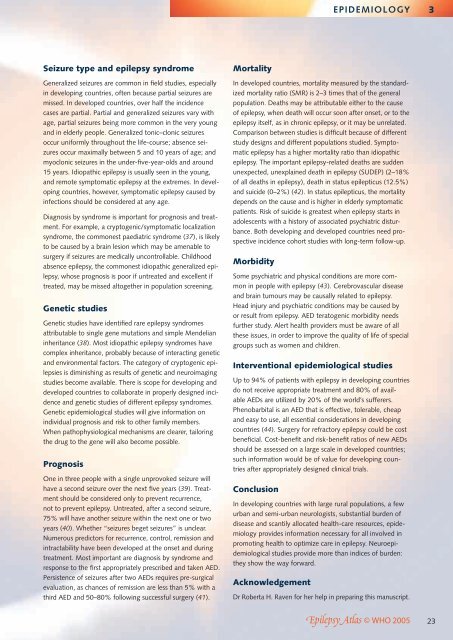Epilepsy - World Health Organization
Epilepsy - World Health Organization
Epilepsy - World Health Organization
Create successful ePaper yourself
Turn your PDF publications into a flip-book with our unique Google optimized e-Paper software.
Seizure type and epilepsy syndrome<br />
Generalized seizures are common in field studies, especially<br />
in developing countries, often because partial seizures are<br />
missed. In developed countries, over half the incidence<br />
cases are partial. Partial and generalized seizures vary with<br />
age, partial seizures being more common in the very young<br />
and in elderly people. Generalized tonic–clonic seizures<br />
occur uniformly throughout the life-course; absence seizures<br />
occur maximally between 5 and 10 years of age; and<br />
myoclonic seizures in the under-five-year-olds and around<br />
15 years. Idiopathic epilepsy is usually seen in the young,<br />
and remote symptomatic epilepsy at the extremes. In developing<br />
countries, however, symptomatic epilepsy caused by<br />
infections should be considered at any age.<br />
Diagnosis by syndrome is important for prognosis and treatment.<br />
For example, a cryptogenic/symptomatic localization<br />
syndrome, the commonest paediatric syndrome (37), is likely<br />
to be caused by a brain lesion which may be amenable to<br />
surgery if seizures are medically uncontrollable. Childhood<br />
absence epilepsy, the commonest idiopathic generalized epilepsy,<br />
whose prognosis is poor if untreated and excellent if<br />
treated, may be missed altogether in population screening.<br />
Genetic studies<br />
Genetic studies have identified rare epilepsy syndromes<br />
attributable to single gene mutations and simple Mendelian<br />
inheritance (38). Most idiopathic epilepsy syndromes have<br />
complex inheritance, probably because of interacting genetic<br />
and environmental factors. The category of cryptogenic epilepsies<br />
is diminishing as results of genetic and neuroimaging<br />
studies become available. There is scope for developing and<br />
developed countries to collaborate in properly designed incidence<br />
and genetic studies of different epilepsy syndromes.<br />
Genetic epidemiological studies will give information on<br />
individual prognosis and risk to other family members.<br />
When pathophysiological mechanisms are clearer, tailoring<br />
the drug to the gene will also become possible.<br />
Prognosis<br />
One in three people with a single unprovoked seizure will<br />
have a second seizure over the next five years (39). Treatment<br />
should be considered only to prevent recurrence,<br />
not to prevent epilepsy. Untreated, after a second seizure,<br />
75% will have another seizure within the next one or two<br />
years (40). Whether “seizures beget seizures” is unclear.<br />
Numerous predictors for recurrence, control, remission and<br />
intractability have been developed at the onset and during<br />
treatment. Most important are diagnosis by syndrome and<br />
response to the first appropriately prescribed and taken AED.<br />
Persistence of seizures after two AEDs requires pre-surgical<br />
evaluation, as chances of remission are less than 5% with a<br />
third AED and 50–80% following successful surgery (41).<br />
Mortality<br />
EPIDEMIOLOGY<br />
In developed countries, mortality measured by the standardized<br />
mortality ratio (SMR) is 2–3 times that of the general<br />
population. Deaths may be attributable either to the cause<br />
of epilepsy, when death will occur soon after onset, or to the<br />
epilepsy itself, as in chronic epilepsy, or it may be unrelated.<br />
Comparison between studies is difficult because of different<br />
study designs and different populations studied. Symptomatic<br />
epilepsy has a higher mortality ratio than idiopathic<br />
epilepsy. The important epilepsy-related deaths are sudden<br />
unexpected, unexplained death in epilepsy (SUDEP) (2–18%<br />
of all deaths in epilepsy), death in status epilepticus (12.5%)<br />
and suicide (0–2%) (42). In status epilepticus, the mortality<br />
depends on the cause and is higher in elderly symptomatic<br />
patients. Risk of suicide is greatest when epilepsy starts in<br />
adolescents with a history of associated psychiatric disturbance.<br />
Both developing and developed countries need prospective<br />
incidence cohort studies with long-term follow-up.<br />
Morbidity<br />
Some psychiatric and physical conditions are more common<br />
in people with epilepsy (43). Cerebrovascular disease<br />
and brain tumours may be causally related to epilepsy.<br />
Head injury and psychiatric conditions may be caused by<br />
or result from epilepsy. AED teratogenic morbidity needs<br />
further study. Alert health providers must be aware of all<br />
these issues, in order to improve the quality of life of special<br />
groups such as women and children.<br />
Interventional epidemiological studies<br />
Up to 94% of patients with epilepsy in developing countries<br />
do not receive appropriate treatment and 80% of available<br />
AEDs are utilized by 20% of the world’s sufferers.<br />
Phenobarbital is an AED that is effective, tolerable, cheap<br />
and easy to use, all essential considerations in developing<br />
countries (44). Surgery for refractory epilepsy could be cost<br />
beneficial. Cost-benefit and risk-benefit ratios of new AEDs<br />
should be assessed on a large scale in developed countries;<br />
such information would be of value for developing countries<br />
after appropriately designed clinical trials.<br />
Conclusion<br />
In developing countries with large rural populations, a few<br />
urban and semi-urban neurologists, substantial burden of<br />
disease and scantily allocated health-care resources, epidemiology<br />
provides information necessary for all involved in<br />
promoting health to optimize care in epilepsy. Neuroepidemiological<br />
studies provide more than indices of burden:<br />
they show the way forward.<br />
Acknowledgement<br />
Dr Roberta H. Raven for her help in preparing this manuscript.<br />
3<br />
23

















